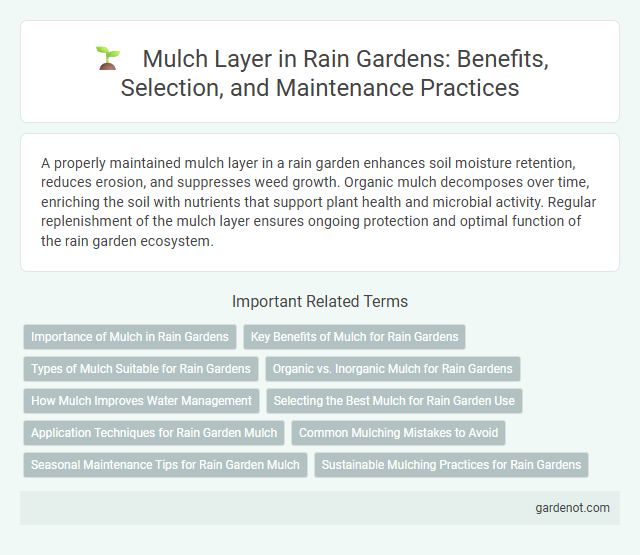A properly maintained mulch layer in a rain garden enhances soil moisture retention, reduces erosion, and suppresses weed growth. Organic mulch decomposes over time, enriching the soil with nutrients that support plant health and microbial activity. Regular replenishment of the mulch layer ensures ongoing protection and optimal function of the rain garden ecosystem.
Importance of Mulch in Rain Gardens
The mulch layer in rain gardens is essential for moisture retention, preventing soil erosion, and suppressing weed growth, which enhances the overall health of the garden. Organic mulch, such as wood chips or shredded bark, improves soil structure and promotes beneficial microbial activity, crucial for nutrient cycling and plant growth. Proper mulch application also moderates soil temperature, creating a stable environment for plant roots and maximizing water infiltration in rain gardens.
Key Benefits of Mulch for Rain Gardens
A mulch layer in rain gardens enhances soil moisture retention by reducing evaporation, which supports healthy plant growth and increases filtration efficiency. It suppresses weed growth, minimizing competition for nutrients and maintaining an aesthetically pleasing garden. Mulch also prevents soil erosion during heavy rains, ensuring the rain garden's structure remains intact and pollutant runoff is reduced.
Types of Mulch Suitable for Rain Gardens
Organic mulches such as shredded bark, hardwood chips, and pine needles are ideal for rain gardens because they improve soil moisture retention while slowly decomposing to enrich the soil. Inorganic mulches like gravel and crushed stone offer excellent drainage and prevent weed growth but must be combined with organic matter to support microbial activity. Selecting mulch with appropriate particle size and durability ensures effective stormwater infiltration and long-term garden health.
Organic vs. Inorganic Mulch for Rain Gardens
Organic mulch in rain gardens, such as wood chips or shredded leaves, enhances soil fertility by decomposing and providing nutrients, while also improving water retention and promoting microbial activity. Inorganic mulch, like gravel or rubber, offers superior durability and weed suppression but lacks nutrient contribution and may affect soil temperature differently. Selecting organic mulch supports long-term soil health and plant growth, whereas inorganic mulch requires less maintenance and is ideal for drainage optimization and erosion control.
How Mulch Improves Water Management
A mulch layer in rain gardens enhances water infiltration by reducing surface runoff and promoting soil moisture retention. Organic mulch materials such as wood chips or bark improve soil structure and increase microbial activity, which supports efficient water absorption and reduces erosion. This natural barrier also slows down the flow of water, allowing rain gardens to effectively manage stormwater and prevent pollutants from entering waterways.
Selecting the Best Mulch for Rain Garden Use
Choosing the best mulch for rain garden use involves selecting materials that enhance water infiltration and support plant health. Organic mulches such as shredded hardwood, pine bark, or composted leaves are preferred due to their ability to regulate soil moisture, reduce erosion, and promote microbial activity. Avoid mulch types that repel water or float easily to ensure optimal rain garden function and longevity.
Application Techniques for Rain Garden Mulch
Applying mulch in rain gardens involves spreading a 2 to 3-inch layer of organic material such as shredded bark, wood chips, or compost around plant bases to retain soil moisture and suppress weeds. Mulch should be kept a few inches away from plant stems to prevent rot and should cover the entire planting area evenly to enhance water infiltration and reduce surface runoff. Regular replenishment of mulch is necessary to maintain its effectiveness in promoting soil health and supporting stormwater management.
Common Mulching Mistakes to Avoid
Applying too thick a mulch layer in a rain garden can impede water infiltration and oxygen flow, leading to root rot and poor plant health. Using inappropriate materials like rubber or dyed mulch introduces harmful chemicals and disrupts the soil ecosystem. Regularly refreshing mulch with organic, natural materials such as shredded bark or hardwood chips maintains soil moisture, prevents erosion, and supports beneficial microbial activity.
Seasonal Maintenance Tips for Rain Garden Mulch
Maintaining a fresh mulch layer in rain gardens enhances water retention and prevents soil erosion throughout seasonal changes, especially during fall when leaf accumulation is high. Inspect mulch thickness regularly, aiming for a 2-3 inch layer to balance moisture control and airflow to plant roots. Remove decomposed mulch annually to replenish with organic, biodegradable material that supports soil health and prevents weed growth.
Sustainable Mulching Practices for Rain Gardens
A mulch layer in rain gardens plays a crucial role in moisture retention, weed suppression, and erosion control while enhancing soil health through organic matter decomposition. Sustainable mulching practices involve using locally sourced, biodegradable materials such as shredded bark, hardwood chips, or leaf litter to promote nutrient cycling and reduce carbon footprint. Maintaining a 2-3 inch mulch depth prevents water runoff and supports microbial activity, ensuring long-term garden vitality and stormwater filtration efficiency.
Mulch layer Infographic

 gardenot.com
gardenot.com